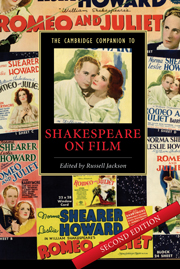Book contents
- Frontmatter
- Introduction: Shakespeare, films and the marketplace
- Part I Adaptation and its Contexts
- 1 From play-script to screenplay
- 2 Video and its paradoxes
- 3 Critical junctures in Shakespeare screen history: the case of Richard III
- 4 Shakespeare and movie genre: the case of Hamlet
- Part II Genres and Plays
- Part III Directors
- Part IV Critical Issues
- Further Reading
- Filmography
- Index
- Series List
2 - Video and its paradoxes
from Part I - Adaptation and its Contexts
Published online by Cambridge University Press: 28 July 2007
- Frontmatter
- Introduction: Shakespeare, films and the marketplace
- Part I Adaptation and its Contexts
- 1 From play-script to screenplay
- 2 Video and its paradoxes
- 3 Critical junctures in Shakespeare screen history: the case of Richard III
- 4 Shakespeare and movie genre: the case of Hamlet
- Part II Genres and Plays
- Part III Directors
- Part IV Critical Issues
- Further Reading
- Filmography
- Index
- Series List
Summary
Videotapes or DVDs, whether they represent a Shakespeare film, a made-for-television production or a transfer of a theatrical version, have become the means by which most academics and students study a Shakespeare play. To anyone interested in performances of Hamlet for instance, the RSC shops and catalogues now offer, alongside the expected videos of Olivier's, Zeffirelli’s or Branagh’s films, videos of live stage performances, from Tony Richardson’s 1969 production of the play with Nicol Williamson, to John Gielgud’s 1964 New York mise-en-scène with Richard Burton. Until 2005 when the BBC Shakespeare series was finally re-issued on DVD, the catalogue of available videos of the play included few versions actually designed for the small screen, but the would-be viewer could always fall back on the half-hour-long cartoons provided by The Animated Tales, a very successful series of videos (complete with study guides), geared to the needs of teenagers confronted with a Shakespeare play on their exam syllabus. This series, which recalls Charles and Mary Lamb’s similar enterprise of popularisation of Shakespeare’s Tales for a public of readers, has so far been translated into thirty-seven languages. Even such a rapid survey is sufficient to indicate that Shakespeare multimedia is alive and well. Thanks largely to the vogue of new technologies and of video and DVD recordings, it is gradually taking over a good part of the Shakespeare industry, which now rests upon a very active educational market.
- Type
- Chapter
- Information
- The Cambridge Companion to Shakespeare on Film , pp. 35 - 46Publisher: Cambridge University PressPrint publication year: 2007

